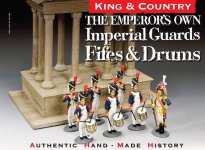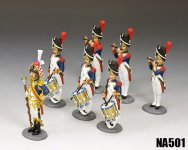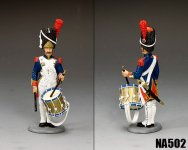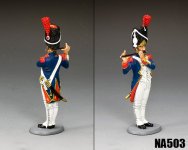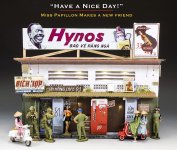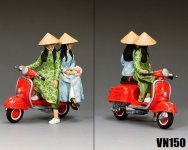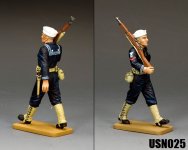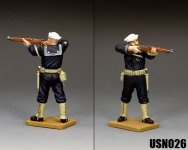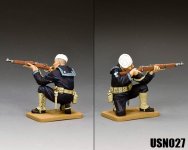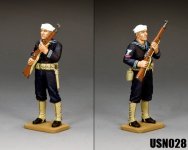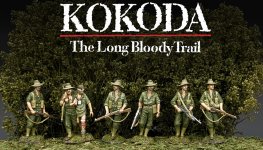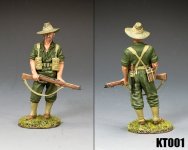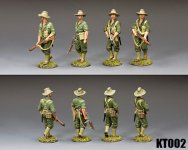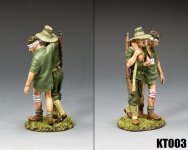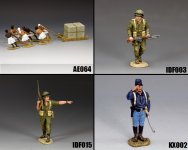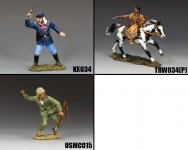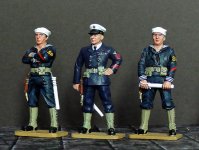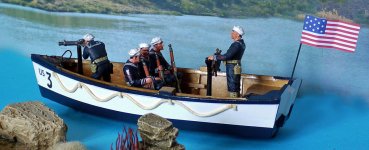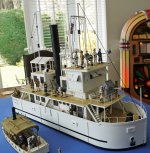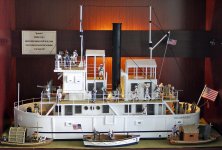King & Country
Captain
- Joined
- May 23, 2005
- Messages
- 5,145
KING & COUNTRY DISPATCHES
August 2022
August 2022
Hi Guys and welcome to this month’s ‘DISPATCHES’ . Again I apologise for the relatively ‘modest’ amount of new items being released this month however as you no doubt know of the continuing difficulties with all production in China and the fact that K&C is still unable to journey into the P.R.C. to meet directly with factories and our sculpting team then you will, I hope, appreciate what items we can introduce today.
So, without further ado, let’s get down to business and this month’s releases...
1. What’s New In August..?
A. ‘The Battle of Goose Green... The Aftermath’
The first crucial land battle of the Falklands War took place over 14 hours on May 28-29, 1982.
Located on East Falkland’s central isthmus, the settlement of Goose Green was also the site of a small airfield. Almost 1200 Argentinean forces, mostly army but some airforce, were in a series of well-defended positions, within striking distance of San Carlos Water, where the British task force had just made its successful amphibious landing and therefor posed a potential threat.
The main British assault force consisted of the 2nd Battalion of the Parachute Regiment (2 Para) together with a troop of three 105mm guns from 29 Commando Regt., Royal Artillery and one Milan anti-tank missile platoon plus several Scout helicopters. In addition, close air support was provided by three Royal Air Force Harriers and naval gunfire from a Royal Navy frigate, HMS Arrow.
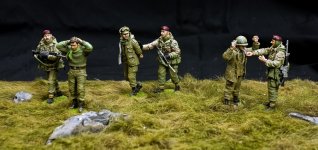
THE ATTACK
Initial intelligence suggested that Goose Green was lightly defended however as the British paras began moving forward across the bare, windswept landscape they came under increasing enemy fire while still managing to force some of their Argentinean opponents to fall back.As the enemy retired they combined with other units and actually strengthened their defence line bringing down heavy machine gunfire on the advancing British forcing them to take cover.
With the advance held up 2 Para’s commanding officer, Lt. Col. ‘H’. Jones moved forward to see for himself the situation on the ground.
To regain the initiative and inspire his men Colonel H. led a charge towards one of the main enemy trenches and was fatally shot down by an Argentine army sniper.
In the hours following the death of their colonel the various elements of 2 Para began moving forward once more fighting a continuing series of fierce skirmishes and fire fights that again forced the enemy back.
BATTLEFIELD SITUATION
By last light on 28 May the British Paratroopers had, after many hours of fighting, surrounded, but not captured, the enemy position at Goose Green. The paras were exhausted, cold and low on water, food and ammunition and their temporary commander, Major Chris Keeble came up with a cunning plan... He sent a message to the Argentine garrison commander offering him the opportunity to surrender his force and save lives or face an ongoing battle the next morning where he and his men would suffer the horrendous consequences... and many more casualties.Early the following day, 29 May, the enemy commander agreed to an unconditional surrender and the Argentineans laid down their arms.
An amazing and vitally important victory was won by guts, perseverance and more than a little guile too!
THE AFTERMATH
No battle, no matter how successful, comes without a cost...The British lost 18 killed (16 Paras, one Royal Marine pilot and one commando engineer) and 64 wounded.
The Argentine forces had almost 60 killed , another 86 wounded and more than 950 captured.
This latest ‘Falklands’ release shows six soldiers of both nations (3 paras and 3 Argentineans) in the immediate aftermath of the surrender as the British ‘Toms’ disarm and escort their prisoners towards a secure holding area.
TF003 “C’mon Pablo Keep moving!”
A young British para urges an enemy captive to move a little bit faster along the way.
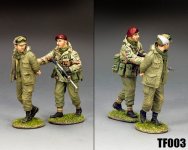
TF004 “Don’t Cry For Me, Argentina”
During the Falklands War this famous song from the popular musical ‘Evita’ was often played by British regimental bands with a strong flavor of sarcasm! The British troops themselves changed the original lyrics to...
“You don’t frighten me Argentina
The truth is we will defeat you
We’ll sink your carrier with our Sea Harrier
And sink you and your submarines too!”
This second paratrooper hums the famous tune as he escorts another P.O.W.
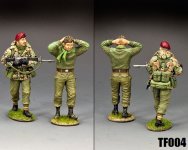
TF005 “Just Making Sure...”
Number three Para conducts a thorough search of this prisoner before allowing him to rejoin his other captured comrades.
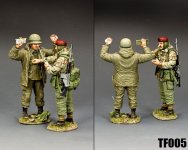
AVAILABLE: Mid August
Special Falklands Note: K&C is already hard at work on additional British Forces in action , including a special figure of Lieut. Col ‘H’ Jones, Victoria Cross and one of Britain’s finest little fighting vehicles... a Blues & Royals Scorpion’ Light Tank
Plus some more of the opposition defending their positions.


